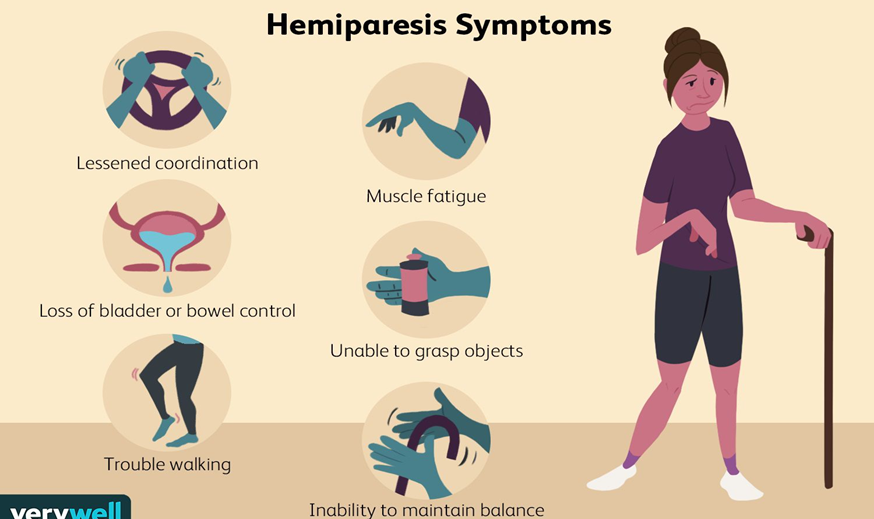A nurse is teaching a client who has left-sided weakness after a stroke on how to use a cane. What instructions should the nurse include?
Hold the cane on the right side to provide support for the weaker leg.
Advance the right leg and the cane together to support the weaker leg.
Remove the rubber tip when using the cane.
Place the cane approximately 61 cm (24 inches) in front of her foot before advancing.
The Correct Answer is A
Choice A reason: Holding the cane on the opposite side of the weaker leg is the correct technique. For a client with left-sided weakness, holding the cane on the right side provides better support and balance. This method helps distribute weight away from the weaker side and reduces the risk of falls. The cane should be moved simultaneously with the weaker leg to maintain stability.

Choice B reason: Advancing the right leg and the cane together is incorrect. The correct technique involves moving the cane and the weaker leg (left leg in this case) together. This coordination helps in maintaining balance and provides the necessary support to the weaker side. Moving the stronger leg and the cane together does not offer the same level of support.
Choice C reason: Removing the rubber tip when using the cane is not advisable. The rubber tip provides traction and prevents the cane from slipping on various surfaces. Removing it would increase the risk of falls and injuries. The rubber tip is an essential safety feature of the cane.
Choice D reason: Placing the cane approximately 61 cm (24 inches) in front of the foot is too far. The cane should be placed about 15-20 cm (6-8 inches) in front of the foot to ensure stability and ease of movement. Placing the cane too far ahead can cause instability and make walking more difficult.
Nursing Test Bank
Naxlex Comprehensive Predictor Exams
Related Questions
Correct Answer is A
Explanation
Choice A reason: Applying compression stockings is a key prophylactic intervention to prevent complications of immobility, such as deep vein thrombosis (DVT) and venous thromboembolism (VTE). Compression stockings help improve blood circulation in the legs by applying graduated pressure, which reduces the risk of blood clots forming in the deep veins. This is particularly important for immobile patients who are at higher risk of developing DVT due to prolonged periods of inactivity.
Choice B reason: Raising all side rails is primarily a safety measure to prevent falls and does not directly address the complications of immobility. While it is important for patient safety, it does not have a significant impact on preventing issues like DVT, pressure ulcers, or muscle atrophy. Therefore, it is not considered a prophylactic intervention for immobility-related complications.
Choice C reason: Inserting a urinary catheter is not a prophylactic intervention for preventing complications of immobility. Catheters are used to manage urinary retention or incontinence but can increase the risk of urinary tract infections (UTIs) if not managed properly. They do not address the primary complications associated with immobility, such as DVT or pressure ulcers.
Choice D reason: Using friction-reducing devices is important for preventing pressure ulcers and skin injuries in immobile patients. These devices help minimize friction and shear forces on the skin, which can lead to pressure ulcers. While this is a valuable intervention, it is not as comprehensive as compression stockings in preventing a range of immobility-related complications.
Correct Answer is C
Explanation
Choice A Reason:
Place suction equipment at the bedside is incorrect. While having suction equipment available is important for emergency situations, it does not directly prevent postoperative pulmonary complications. Suction equipment is used to clear the airway if the client has difficulty breathing or if there is an obstruction.
Choice B Reason:
Administer a prophylactic expectorant is incorrect. Prophylactic expectorants can help in managing secretions, but they are not the primary intervention for preventing postoperative pulmonary complications. The main goal is to promote lung expansion and prevent atelectasis.
Choice C Reason:
Encourage the use of an incentive spirometer is correct. Using an incentive spirometer encourages deep breathing and lung expansion, which helps prevent atelectasis and other postoperative pulmonary complications. It is a key intervention in postoperative care to maintain optimal lung function.
Choice D Reason:
Perform range of motion exercises is incorrect. While range of motion exercises are important for preventing musculoskeletal complications and promoting circulation, they do not directly prevent pulmonary complications. The focus for pulmonary health is on lung expansion and clearing secretions.
Whether you are a student looking to ace your exams or a practicing nurse seeking to enhance your expertise , our nursing education contents will empower you with the confidence and competence to make a difference in the lives of patients and become a respected leader in the healthcare field.
Visit Naxlex, invest in your future and unlock endless possibilities with our unparalleled nursing education contents today
Report Wrong Answer on the Current Question
Do you disagree with the answer? If yes, what is your expected answer? Explain.
Kindly be descriptive with the issue you are facing.
